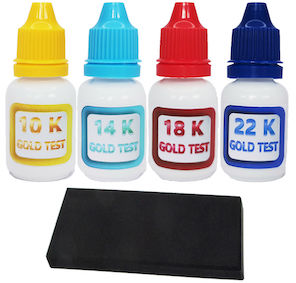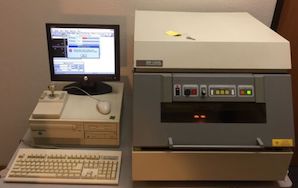
-----
Gold Plating Problems with Jewelry, How to make gold plating last longer? PVD?
Q. Hi all, I wanted to know if there is a maximum thickness of gold plating that should be applied that will ensure good wear and resist peeling of the plating, etc. If you have a gold plating layer, for example, 40 micron thick, what problems or benefits does this pose?
Thanks for your help.
Geno
- United Kingdom
April 15, 2015
Hi Geno. Peeling is more often related to poor preparation than the thickness of the plating. It is possible to do 40 microns thick (for electroforms for example), but "nobody" does gold plating that thick. The world's most expensive watches have plating of 7-20 microns; vermeil is 2-1/2 microns; and good quality costume jewelry is 1 micron.
Regards,

Ted Mooney, P.E. RET
Striving to live Aloha
finishing.com - Pine Beach, New Jersey
Ted is available for instant help
or longer-term assistance.
April 2015
A. Hi, We are 20 years in Gold plating. We were plating 10 micron / 5 micron hard gold plating, (even duplex coat of 18 kt followed by 23.5 kt hard gold) for watch parts. As the gold cost shot up over the years, the thickness specs gradually came down to 1 micron hard gold followed by clear EP coat of about 8 microns (no orange peel/drip marks).
Presently it is 0.5 micron of TiN PVD followed by 0.1 micron of gold PVD in the same PVD machine. We have been successful in EP coat on top of the PVD coats by which we are able to guarantee gold plating of watch parts, pen parts, Imitation jewellery, temple decorations etc., and make it LAST and NOT LOST!
- Bangalore, India
May 12, 2015
Ed. note: We assume that in this context EP stands for electro-phoretic, i.e., electrocoating.
![]() Hi. Congratulations on reducing your use of gold by a factor of 100X while simultaneously improving the durability of the jewelry! However, I need to quibble because what you are guaranteeing is a "TiN based gold-ish tone/look"; you are clearly not guaranteeing the "gold plating" if you have only 10¢ worth of gold on it :-)
Hi. Congratulations on reducing your use of gold by a factor of 100X while simultaneously improving the durability of the jewelry! However, I need to quibble because what you are guaranteeing is a "TiN based gold-ish tone/look"; you are clearly not guaranteeing the "gold plating" if you have only 10¢ worth of gold on it :-)
Regards,

Ted Mooney, P.E. RET
Striving to live Aloha
finishing.com - Pine Beach, New Jersey
Ted is available for instant help
or longer-term assistance.
July 2015
What clear coat can be applied to gold plating that WON'T get scratched?
Q. The question remains unanswered on what clear coat can be applied to gold plating that WON'T scratch off or get scratched easily. I spent an hour looking for the answer on the topic in this thread of how to protect plating and found nothing but talk on the different thicknesses and types of plating.
Renaissance wax is not good durable enough. E-coating by Klier is not really that durable. Everbrite scratches off.
Please tell me (and others) what is applied to brushed stainless steel appliances, plated watches, faucets or gold hand railings at a casino? I can't find anything other than cheap lacquer that scratches. The big plating companies use a baked on clear coat and they don't share anything. I have seen the type of product referred to in the thread but never a name! We need a name of a product that is clear, durable and is commonly used for watches and other high wear, metal items.
Jeweler & Designer - Austin, Texas USA
June 1, 2015
![]() Hello A. I don't think I agree at all with your assessment of this thread nor your conclusions about how other people produce and protect their gold-tone finishes.
Hello A. I don't think I agree at all with your assessment of this thread nor your conclusions about how other people produce and protect their gold-tone finishes.
Jim Teglio and others have told us that most gold-tone faucets don't use any gold -- just titanium nitride (TiN) Physical Deposition (PVD) coatings; and that good watches use TiN PVD coatings plus a little gold which wears off over time but still looks enough like gold. I believe them, and assume that "gold hand railings at a casino" are either TiN, solid brass, or brass plated -- not gold plated. TiN isn't a clearcoat, it's a nitride which looks like gold, but is much harder than gold and much much harder and more scratch resistant than a clearcoat.
Unfortunately, this brings the practical problem that small jewelry designers often can't apply that technology because it requires million dollar PVD vacuum chambers which is too capital intensive for them. Small jewelers are limited to such products as waxes like Renaissance, single-component clearcoats like Everbrite and ProtectaClear, 2-component coatings like automotive clearcoats, e-coatings like Kliar, and UV-hardened clearcoats such as are applied in manicure salons. These options would quickly be gone, rather than widely sold and widely used, if there actually was a secret formula "baked on clearcoat" which is manifestly better, and cannot be scratched (but baking does improve some of the mentioned clearcoats).
There is still another approach, but it is probably economically prohibitive: really heavy gold plating. Some gold plated pocket watches have lasted a century without any clearcoat at all. But gold of high thickness is generally considered cost-prohibitive these days. Good luck.
Regards,

Ted Mooney, P.E. RET
Striving to live Aloha
finishing.com - Pine Beach, New Jersey
Ted is available for instant help
or longer-term assistance.
Q. Hi , I work as a custom jewelry agency . Recently my client has asked me about real gold plating, and they mentioned measure unit "micron" , however when I check with some of my plating suppliers, they reply with "mils" . What is the difference between these two and is there a way to convert? Thank you .
Jonathan Sam- China, HongKong
June 5, 2015
Hi Jonathan. Fortunately, that one is easy :-)
A micron (µ or µm or micrometer) is one millionth of a meter, but a mil is one thousandth of an inch. So a mil is 25.4 microns, and a micron is 0.0394 mils.
Multiply mils by 25.4 to get microns; multiply microns by 0.0394 to get mils.
But be wary, because a small number of people will always try to mislead us for their personal gain, and they have apparently now invented the abbreviation "mills" for millionths of an inch so they can talk nonsense like "heavy 10 mill gold plating", which is actually only 1/100th of a mil :-)
Regards,

Ted Mooney, P.E. RET
Striving to live Aloha
finishing.com - Pine Beach, New Jersey
Ted is available for instant help
or longer-term assistance.
How to verify and test e-coating on gold flashed jewelry
Q. Hello,
I am manufacturing costume jewelry through a third party and want to ensure there is an e-coating on the gold flash. I would like to do so by making the products go through a sort of quality control. What can I do to test a piece of jewelry to ensure it will last at least one year without fading? Thanks!
- Chicago, Illinois
June 12, 2015
A. Hi Allison,
You can test for e-coating using the ohms range of an electric multimeter. Put the prods on the item to be tested. If there is no coating, you will get a very low resistance reading. If the item is coated, the resistance will be near infinity. If the meter has sharp pointed prods (they usually do) there is a danger the ends of the prods will push through the coating and give a false reading. So, use the sides of the prods or better still remove the points and grind a smooth, gentle radius on the ends.
I would introduce further quality controls.
1) check that the coating is sufficiently thick so as not produce iridescence (like oil an water)
2) do a solvent rub test (acetone or methyl ethyl ketone) to check that the coating is well cured
3) do a pencil hardness test, another test of mainly curing
If any of these tests are of interest to you I would be happy to provide more details of the procedures.
Harry

Harry Parkes
- Birmingham, UK
Q. Hi
I've read right through this excellent thread which has given me SO much information and insight. I would greatly appreciate it if someone would clarify a couple of things for me:
Does PVD TiN plate include gold or is it possible for a supplier to 'exclude' this. I've asked for the plating to be done to 1 micron with hard gold for durability and have been told that using hard gold would not be as smooth, and that PVD is best. I'm wondering if standard electroplating techniques with hard gold is better quality and more in line with industry standards (brands such as Monica Vinader, Links)?
Is there any way to test the amount (micron) & quality (carat) of plate?
Thanks in advance for any help.
Jewellery Production Manager - London, UK
September 3, 2015
A. Hi Helen. Gold CAN be deposited by PVD techniques but it isn't customary because gold electroplating is far less capital intensive. Yes, one micron gold plating can be used on good quality costume jewelry.
It is possible to check the thickness of the gold plating with X-Ray fluorescence thickness testing machines, but they are by no means cheap (say $30K and up). Testing the karat is supposedly possible with inexpensive acid test kits, but I think this is destructive testing and cannot be done on clearcoated items.
Regards,

Ted Mooney, P.E. RET
Striving to live Aloha
finishing.com - Pine Beach, New Jersey
Ted is available for instant help
or longer-term assistance.
August 2016
18kt gold plating on top of PVD/IPG colour tones
Q. Hi Everyone,
I have designed a watch that I am looking to get produced. The watch will be made from 316L stainless steel. I am currently deciding on the plating process to apply to the stainless steel. Is it possible to have a layer of IPG/PVD colouring (3 microns), and then apply 18kt-gold plating on top of that (of 2 microns)?
My reasoning behind this is that if/when the 18kt plating starts to wear, there would be a layer below to mask the wear.
Any help on this is much appreciated
Thanks
Martin
Product designer - Leeds
September 30, 2015
⇦ on eBay or Amazon [affil link] patented that sequence years ago for their watches. I'm not sure if they plated the gold or deposited it by PVD as well as the TiN PVD layer, so I don't know whether it is possible to gold plate the PVD coating. The more common method is to skip the gold layer and just apply a PVD coating that looks like gold.

Jim Treglio - scwineryreview.com
PVD Consultant & Wine Lover
San Diego, California
September 30, 2015
Q. It is a common practise to deposit TiN first (by cathodic arc/sputtering) and then deposit gold by sputtering in the same chamber without breaking vacuum. I wonder if it is possible to electroplate gold on TiN.
H.R. PrabhkaraBangalore Plasmatek - Bangalore, Karnataka, India
October 1, 2015
Mils vs Microns in jewelry production
October 23, 2015Q. Hello,
I have a jewelry line in Los Angeles. We have been having trouble with plating our costume jewelry pieces.
1. One plating house said he plates the pieces in 10-20 mils of gold and that the industry standard is more like 6-12 Mils, is that true? His plating comes off pretty quickly.
2. Another plater puts a clear coat over the plating but it often begins to peel off. Why would it do this? Is that normal?
3. Is there a industry standard for costume jewelry plating. We are not super expensive/but not too cheap ($25-$185) and want people to have lasting plating while keeping the pricing down. Any suggestions?
RFQ: Any LA based plater recommended, we have had a hard time finding good quality!
Thank you!
Nicole
- Los Angeles, California, USA
![]() Hi Nicole. For the 50 years that I've been in the plating industry a "mil" meant one thing: a thousandth of an inch, i.e., 25.4 microns --
Hi Nicole. For the 50 years that I've been in the plating industry a "mil" meant one thing: a thousandth of an inch, i.e., 25.4 microns --
www.dictionary.com: "... a unit of length equal to 0.001 of an inch ..."
www.merriam-webster.com: "... a unit of length equal to 0.001 of an inch ..."
www.thefreedictionary.com: "... a unit of length equal to 0.001 of an inch ..."
www.oxforddictionaries.com: "One thousandth of an inch ... Origin late 17th century from Latin millesimum 'thousandth', from mille 'thousand"
Lately, jewelry platers have been using "mil" or "mill" to mean a millionth of an inch, i.e., one thousand times thinner; sometimes they add an extra 'l', 'mill', perhaps for plausible deniability about their attempt to obfuscate :-)
So 6 of their "mills" is only .15 microns, and 20 of their "mills" is about 1/2 micron (1 micron used to be considered good quality costume jewelry; vermeil is 2-1/2 microns, and top quality plating on super premium watches is probably about 7 microns). What that means to you as a buyer is that the gold is only there for color and won't last a day without a clearcoat, so you must find a shop whose clearcoat doesn't peel. Whether the actual gold value is 1¢ vs. 4¢ shouldn't be much of a concern on $25-$185 jewelry.
Regards,

Ted Mooney, P.E. RET
Striving to live Aloha
finishing.com - Pine Beach, New Jersey
Ted is available for instant help
or longer-term assistance.
! Hi Mat,
I have been gold plating Jewellery for the past 30 yrs. Usually it can last several yrs. If not wearing, no tarnish for more than 10 years. Usually when a person wearing it, they should avoid perfume spray.
The actual secret is after the copper coating, you had to either go thru nickel coating or any non-nickel undercoating before gold plating.The secret is go to 18k hard gold coating. This hard gold coating must be 3 micron minimum thickness then into final gold coating of your choice. The final coating is color only, and whether 14k, 18k or 24k gold is only a one micron coating. Use gold powder salt for coating NOT real gold coating which is soft.
This sure will last as I've been in this trade for the past 30 years.
Jenues Worldwide Sdn Bhd - Petaling Jaya, Kuala Lumpur, Malaysia
May 5, 2016
![]() Hi Jeffrey. Thanks for continuing to do great quality gold plating. I think there are few people like you anymore :-)
Hi Jeffrey. Thanks for continuing to do great quality gold plating. I think there are few people like you anymore :-)
Regards,

Ted Mooney, P.E. RET
Striving to live Aloha
finishing.com - Pine Beach, New Jersey
Ted is available for instant help
or longer-term assistance.
May 2016
Q, A, or Comment on THIS thread -or- Start a NEW Thread

